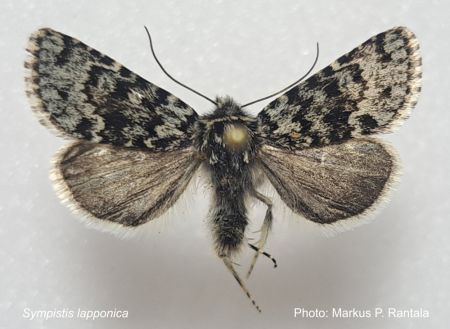Newly available Pherobank products, pheromone lures for Syngrapha parilis and for Sympistis lapponica
In a joint effort with Markus P. Rantala1 to formulate a new attractant for Polia species, interestingly one of the pheromone mixtures was found to attract large numbers of Syngrapha parilis and another large numbers of Sympistis lapponica.
Left photo: modified funnel trap placed on the ground
Right photo: same kind of trap in North Finland, Utsjoki, Ailigas mountain, Lapland tundra
(photos: Markus P. Rantala)
Syngrapha parilis

Syngrapha parilis is a species of looper moth in the family Noctuidae. It is found in North America and Europe. It is the smallest species of Syngrapha (wingspan is 22-28 mm), and is a day-flying northerly species. This species is easily identified by the combination of a silver stigma on the forewing with a grey and white hindwing. It is the only species in the subfamily Plusiinae with white hindwing colour. S. parilis is a foodplant specialist feeding on dwarf willows (Salix spp.) on arctic shrub tundra. Adults fly in Finland during the summer, usually in late June – early July. This species is strictly diurnal and visits flowers to feed.
(Z)-7-Dodecenyl acetate has been reported to be attractive to S. parilis by Linnaluoto and Koponen2. however moderate numbers of attracted S. parilis have been reported since with this single compound. In this experiment it appeared that the addition of (Z)-11-tetradecenyl acetate greatly enhanced the attractivity towards S. parilis. In the period 28.6 – 8.7.2022 large numbers of S. parilis have been caught with two specially adapted funnel traps.
Sympistis lapponica

Sympistis lapponica is a moth of the family Noctuidae. It is found in Fennoscandia and northern Russia, Asia and northern North America. The wingspan is 23 -26 mm. The forewings are grey with black markings and chequered fringes. The hindwings are grey with a vague white line and white fringes. In Finland adults are on wings usually late June – early July. The larvae feed on Vaccinium species (including Vaccinium myrtillus) and Betula nana. The species overwinters twice, once as an egg and the second time in the pupal stage.
Also (Z)-7- dodecenyl acetate has been reported to be attractive to another Sympistis species namely S. heliophila by Linnaluoto and Koponen2. A pheromone blend used in our experiment consisting of only (Z)-9-tetradecenyl acetate and (Z)-11-hexadecenyl acetate appeared highly attractive towards S. lapponica. In the period 28.6 – 8.7.2022 the special modified funnel traps captured large numbers of of this species.
-----------------------------------------
1 Markus P. Rantala (email: perhosmaailma@luukku.com)
2 Linnaluoto, E.T., and Koponen, S. 1983. Northern moths (Lepidoptera) attracted by synthetic pheromones. Ann. Entomol. Fenn. 49:64
Syngrapha parilis pheromone lure, Pherobank article #: 50469
Sympistis lapponica pheromone lure, Pherobank article #: 50467
Tips for collecting insects with pheromones by Markus P. Rantala
- The key point is timing, place the pheromone before the females emerge.
- Try to find out the type of places females tend to sit and use similar places to position the pheromone (usually males fly around trying to find females).
- If your target species is a diurnal flyer -> use traps made of transparent material.
- When collecting specimens for collections, use large traps, which will keep the insect in better condition.
- Sometimes the pheromone formula is not perfect and target species only fly near the pheromone and then quickly fly away. In this case it is also advisable to have a net at hand to catch the insects.


